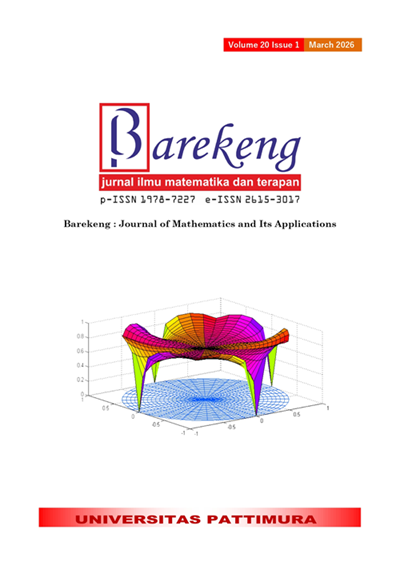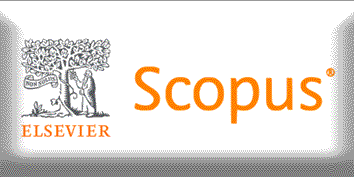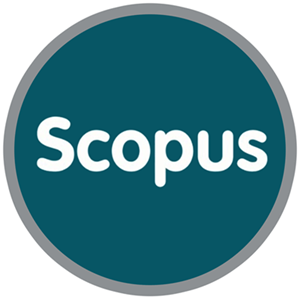POISSON MIXED MODELS WITH A BOOSTING APPROACH FOR THE ANALYSIS OF COUNT DATA
Abstract
Boosting is a powerful technique for enhancing predictive accuracy by iteratively reweighting observations, and is particularly effective in high-dimensional settings and for variable selection. While previous studies have demonstrated the advantages of integrating boosting with generalized linear mixed models (GLMMs) for binary outcomes, its application to count data within hierarchical frameworks remains limited. This study addresses that gap by extending boosting methods to count data through the development of a boosted Poisson mixed model (bPMM), a novel approach for small area estimation and variable selection in complex survey designs. The proposed model is applied to fertility data in the Indonesian provinces of Bali and East Nusa Tenggara, where the response variable is the number of live births and the predictors include twenty-eight socio-demographic covariates. Using the Akaike Information Criterion (AIC) for model selection, three significant variables were identified in Bali (Model 1), and one in East Nusa Tenggara (Model 2). The results demonstrate that bPMM not only improves variable selection in high-dimensional settings but also accommodates hierarchical structure in count data.
Downloads
References
T. Hastie, R. Tibshirani, and J. Friedman, THE ELEMENTS OF STATISTICAL LEARNING: DATA MINING, INFERENCE, AND PREDICTION, 2nd ed. New York: Springer, 2009. [Online]. Available: https://link.springer.com/book/10.1007/978-0-387-84858-7?utm_source=chatgpt.com
M. Balzer, E. Bergherr, S. Hutter, and T. Hepp, GRADIENT BOOSTING FOR DIRICHLET REGRESSION MODELS, no. 0123456789. Springer Berlin Heidelberg, 2025. doi: https://doi.org/10.1007/s10182-025-00526-5
A. Alsahaf, N. Petkov, V. Shenoy, and G. Azzopardi, “A FRAMEWORK FOR FEATURE SELECTION THROUGH BOOSTING”, Expert Syst. Appl., vol. 187, no. Sept. 2021, p. 115895, 2022. doi: https://doi.org/10.1016/j.eswa.2021.115895.
G. Schultz Lindenmeyer and H. da Silva Torrent, “BOOSTING AND PREDICTABILITY OF MACROECONOMIC VARIABLES: EVIDENCE FROM BRAZIL”, vol. 64, no. 1. Springer US, 2024. doi: https://doi.org/10.1007/s10614-023-10421-3.
P. Bühlmann and T. Hothorn, “BOOSTING ALGORITHMS: REGULARIZATION, PREDICTION AND MODEL FITTING”, Stat. Sci., vol. 22, no. 4, pp. 477–505, 2007. doi: https://doi.org/10.1214/07-STS242.
Y. Freund and R. E. Schapire, “EXPERIMENTS WITH A NEW BOOSTING ALGORITHM”, Proc. 13th Int. Conf. Mach. Learn., pp. 148–156, 1996, doi: https://doi.org/10.1.1.133.1040.
R. Wang, “ADABOOST FOR FEATURE SELECTION, CLASSIFICATION AND ITS RELATION WITH SVM, A REVIEW”, Phys. Procedia, vol. 25, pp. 800–807, 2012. doi: https://doi.org/10.1016/j.phpro.2012.03.160.
L. Pebrianti, F. Aulia, H. Nisa, and K. Saputra S, “IMPLEMENTATION OF THE ADABOOST METHOD TO OPTIMIZE THE CLASSIFICATION OF DIABETES DISEASES WITH THE NAÏVE BAYES ALGORITHM”, J. Sist. dan Teknol. Inf., vol. 7, no. 2, pp. 122–127, 2022, [Online]. Available: http://jurnal.unmuhjember.ac.id/index.php/JUSTINDO
P. Beja-Battais and C. Borelli, “OVERVIEW OF ADABOOST : RECONCILING ITS VIEWS TO BETTER UNDERSTAND ITS DYNAMICS”, arXiv:2310.18323v1, pp. 3–31, 2023, [Online]. Available: http://arxiv.org/abs/2310.18323
J. Friedman, T. Hastie, and R. Tibshirani, “ADDITIVE LOGISTIC REGRESSION: A STATISTICAL VIEW OF BOOSTING”, Ann. Stat., vol. 28, no. 2, pp. 337–374, 2000. doi: https://doi.org/10.1214/aos/1016120463.
A. S. Suggala, B. Liu, and P. Ravikumar, “GENERALIZED BOOSTING,” in Advances in Neural Information Processing Systems 33, H. Larochelle, M. Ranzato, R. Hadsell, M. F. Balcan, and H. Lin, Eds. Vancouver, Canada: NeurIPS, 2020.
L. Knieper, T. Hothorn, E. Bergherr, and C. Griesbach, “GRADIENT BOOSTING FOR GENERALISED ADDITIVE MIXED MODELS”, Stat. Comput., vol. 35, no. 4, 2025. doi: https://doi.org/10.1007/s11222-025-10612-y.
G. Tutz and A. Groll, “LIKELIHOOD-BASED BOOSTING IN BINARY AND ORDINAL RANDOM EFFECTS MODELS”, J. Comput. Graph. Stat., vol. 22, no. 2, pp. 356–378, Jan. 2013. doi: https://doi.org/10.1080/10618600.2012.694769.
E. Fammaldo and M. Lestari, “GRADIENT BOOSTING TREES UNTUK PEMODELAN DAN PREDIKSI BIAYA KERUGIAN ASURANSI MOBIL”, no. 01, pp. 634–642, 2024.
Y. Yang, W. Qian, and H. Zou, “A BOOSTED TWEEDIE COMPOUND POISSON MODEL FOR INSURANCE PREMIUM”, arXiv:1508.06378v2 [stat.ME], p. 11, Aug. 2016. doi: https://doi.org/10.1080/07350015.2016.1200981.
Badan Pusat Statistik, “HASIL SENSUS PENDUDUK 2020”, in Statistik Demografi Indonesia, Badan Pusat Statistik, 2025.
Kementrian Kesehatan RI, Badan Pusat Statistik RI, and USAID, SURVEI DEMOGRAFI DAN KESEHATAN INDONESIA TAHUN 2017. 2018. [Online]. Available: https://ia802800.us.archive.org/30/items/LaporanSDKI2017/Laporan SDKI 2017.pdf
G. Willame, J. Trufin, and M. Denuit, “BOOSTED POISSON REGRESSION TREES: A GUIDE TO THE BT PACKAGE IN R”, Ann. Actuar. Sci., vol. 18, no. 3, pp. 605–625, 2024. doi: https://doi.org/10.1017/S174849952300026X.
F. Hadiji, A. Molina, S. Natarajan, and K. Kersting, “POISSON DEPENDENCY NETWORKS: GRADIENT BOOSTED MODELS FOR MULTIVARIATE COUNT DATA”, Mach. Learn., vol. 100, no. 2–3, pp. 477–507, 2015. doi: https://doi.org/10.1007/s10994-015-5506-z.
G. Gao, H. Wang, and M. V. Wüthrich, “BOOSTING POISSON REGRESSION MODELS WITH TELEMATICS CAR DRIVING DATA”, Mach. Learn., vol. 111, no. 1, pp. 243–272, 2022. doi: https://doi.org/10.1007/s10994-021-05957-0.
L. Breiman, “ARCING CLASSIFIERS”, Ann. Stat., vol. 26, no. 3, pp. 801–824, Jun. 1998, [Online]. Available: http://www.jstor.org/stable/120055. doi: https://doi.org/10.1214/aos/1024691079
J. H. Friedman, “GREEDY FUNCTION APPROXIMATION: A GRADIENT BOOSTING MACHINE”, Ann. Stat., vol. 29, no. 5, pp. 1189–1232, 2001, [Online]. Available: http://www.jstor.org/stable/2699986?origin=JSTOR-pdf. doi: https://doi.org/10.1214/aos/1013203451
P. Bühlmann and B. Yu, “BOOSTING WITH THE L2 LOSS: REGRESSION AND CLASSIFICATION”, J. Am. Stat. Assoc., vol. 98, no. 462, pp. 324–339, 2003. doi: https://doi.org/10.1198/016214503000125.
Copyright (c) 2025 Ita Wulandari, Khairil Anwar Notodiputro, Bagus Sartono, Anwar Fitrianto, Anang Kurnia

This work is licensed under a Creative Commons Attribution-ShareAlike 4.0 International License.
Authors who publish with this Journal agree to the following terms:
- Author retain copyright and grant the journal right of first publication with the work simultaneously licensed under a creative commons attribution license that allow others to share the work within an acknowledgement of the work’s authorship and initial publication of this journal.
- Authors are able to enter into separate, additional contractual arrangement for the non-exclusive distribution of the journal’s published version of the work (e.g. acknowledgement of its initial publication in this journal).
- Authors are permitted and encouraged to post their work online (e.g. in institutional repositories or on their websites) prior to and during the submission process, as it can lead to productive exchanges, as well as earlier and greater citation of published works.






1.gif)



